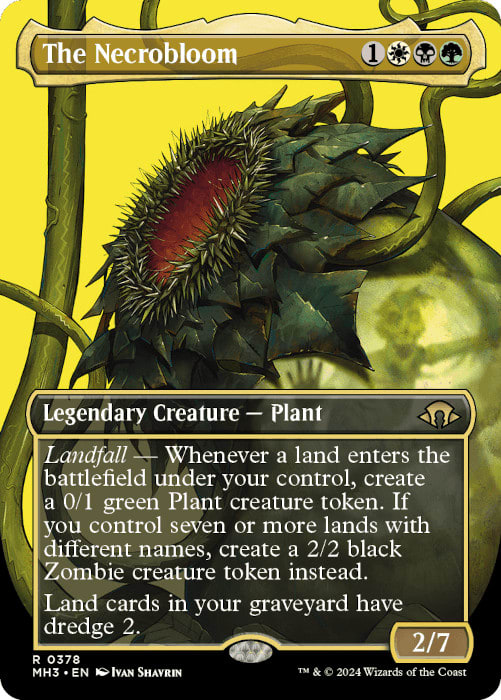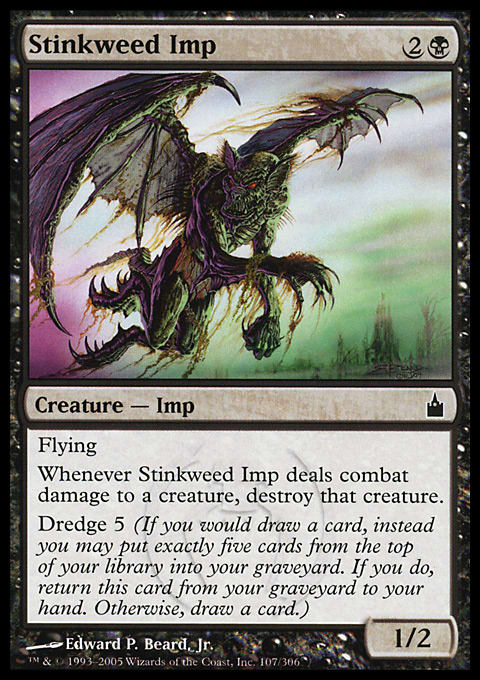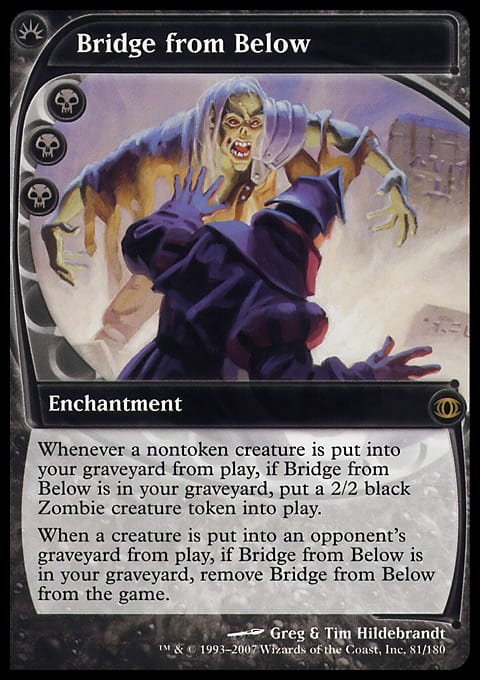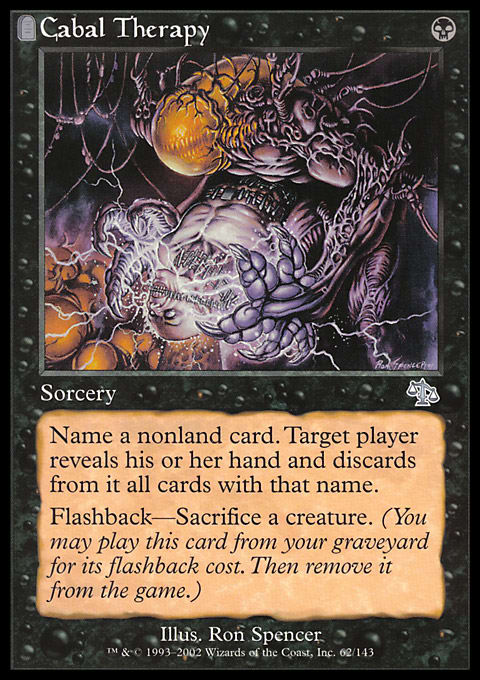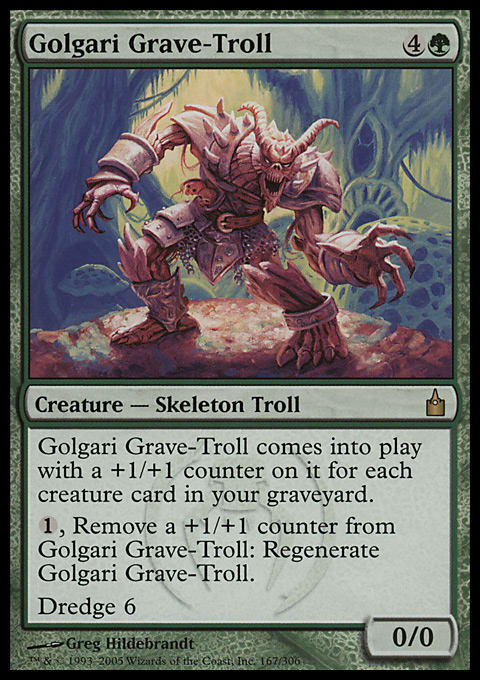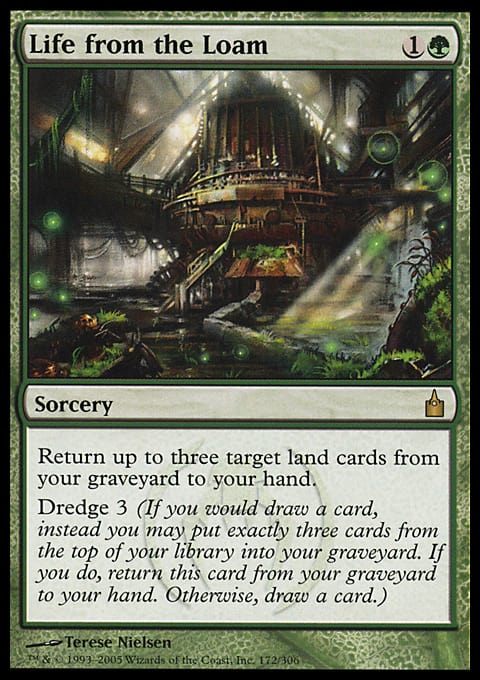Bazaar of Baghdad is a strange card. In a vacuum, the card's power is suspiciously obscure - why would I want to play a land that can't tap for mana, and yields card disadvantage with every activation?
I'm sure that back in 1990s, players found ways of exploiting this card's ability to good effect. However, it wasn't until the launch of Ravnica in 2005 when this card's true power could be fully harnessed. Why Ravnica? The answer can be summed up with one simple word: Dredge.
What's Dredge?
You don't see the Dredge ability in premier Magic sets these days. The keyword showed up in Ravnica, and has only appeared on reprints or special-release product ever since. The most recent, novel printing of a card that features Dredge is The Necrobloom, from Modern Horizons 3.
Let's read through that reminder text to understand what Dredge actually does. The Necrobloom grants all land cards in your graveyard "dredge 2." In other words, "You may return a land card from your graveyard to your hand and mill two cards instead of drawing a card."
Dredge is a recursion mechanic and acts like a replacement effect. You can utilize a card's Dredge ability as long as the card is in your graveyard and you're about to draw a card. Most commonly, this occurs when you draw a card during your draw phase. If you draw cards at other times thanks to a spell or ability (such as the activation of Bazaar of Baghdad), you can choose to Dredge instead for each card you would draw. Therefore, for zero mana and in an uncounterable way, Bazaar of Baghdad gives you two opportunities to Dredge!
Dredge's Power
If you're unfamiliar with eternal, non-rotating formats such as Modern, Legacy, and Vintage, you may be scratching your head as to why someone would want this ability? The ability to recur lands, in the case of The Necrobloom, has some utility in a vacuum, but it's the creature's Landfall ability that brings everything together. By itself, Dredge can seem underwhelming, especially when it's on an unexciting creature such as Stinkweed Imp.
Do you really want a 1/2 Flying, Deathtouch creature for 3 mana instead of a card off the top of your deck? There aren't too many scenarios where this would be better than a top-deck (assuming your deck is built competitively).
Why, then, is Dredge considered a nine on the Storm Scale? (Never say never, but this would require a minor miracle to reappear in a Standard-legal set). For starters, the mechanic is inherently repetitive, and according to the MTG Wiki, "...changing the mana cost of dredge spells does not do much to its playability, making it impossible to balance." In other words, no one really cares what a Dredge card's casting cost is - all that matters is how many cards you get to mill upon activating its Dredge ability.
With the right deck design, being able to mill a ton of cards in a way that's nearly impossible to interact creates a vastly different game of Magic. Consider, for instance, the cards Ichorid and Bridge from Below.
Can you see how these cards interact favorably with the Dredge mechanic? If you Dredge Ichorid into your graveyard when activating the Dredge ability on Stinkweed Imp, then it's likely you'll soon get to return Ichorid to the battlefield for free over and over again.
Bridge from Below is a very bizarre Magic card. I've seen this card played in many Legacy decks over the years, but I don't think I've ever seen it cast. Its real power is unleashed when the Enchantment is in your graveyard! Remember that Ichorid you're recycling over and over again? Well, when it dies, if Bridge from Below is in your graveyard, you'll get a free 2/2 zombie creature token. Every. Single. Time. As you dredge over and over, you're likely to mill multiple copies of these cards, and they stack!
What are you going to do with all those 2/2 zombie creatures? Well, eventually you'll attack your opponent with them to win. Before then, however, you can use your creatures to flashback spells from your graveyard - Cabal Therapy is a popular choice.
Other cards that power up a Dredge deck include Bloodghast and Prized Amalgum, and Narcomoeba.
All of these cards interact so well together, and all you need to do is start milling yourself with Dredge creatures. Once you get the ball rolling, and get that first Dredge card in your graveyard, the deck engine snowballs. Since you're mostly playing cards from your graveyard, it almost feels like a Dredge player isn't playing the same game you are. The only way to interact favorably when battling against a Dredge deck is to disrupt its graveyard, which isn't always so easy to accomplish.
The List of Dredge Cards
Let's take a look at the these Dredge cards. By my count, there are 14 cards that directly contain the Dredge ability:
- Dakmor Salvage (the only land with Dredge)
- Darkblast (the only instant with Dredge)
- Golgari Brownscale (gains you life when you Dredge it)
- Golgari Grave-Troll (Dredge 6 makes this the most potent in Dredge decks)
- Golgari Thug
- Grave-Shell Scarab
- Greater Mossdog
- Life from the Loam (known for its versatility in Legacy Lands)
- Moldervine Cloak (an aura with Dredge)
- Necroplasm
- Nightmare Void
- Shambling Shell
- Shenanigans (a red card with Dredge)
- Stinkweed Imp (Dredge 5 makes this the second most potent)
The list isn't that long. This is because this was a Golgari mechanic when printed in Ravnica, so you'll see the ability mostly on Black/Green cards. Add in the fact that this has a nine on the Storm Scale, and you end up with a sparsely used mechanic.
The group of cards is small, but they are mightily impactful! The Dredge ability has led to the creation of entire decks built around the mechanic in every non-rotating format: Vintage Dredge with Bazaar of Baghdad and Serum Powder, Legacy Dredge with Bridge from Below and Breakthrough, and Modern Dredge with Prized Amalgam and Creeping Chill. No matter the Eternal format, there are cards that combine with Dredge to form a powerful deck that is difficult to disrupt.
Wrapping It Up
The power generated by this keyword surprised everybody. It's incredible how a short list of just 14 cards led to the creation of an entire archetype in Modern, Legacy, and Vintage. The strategy is so popular, in fact, that Bazaar of Baghdad has since become the most valuable card from Arabian Nights! Heavily played copies will set you back nearly $2000, and nicer copies go for a few hundred above that.
If you ever want to see Magic played in a completely different way, I'd encourage you to check out videos showcasing gameplay of this deck. It is so weird to walk past a Dredge player and see their graveyard spread out all over the table as they're playing the game.
Just don't expect to see Dredge show up in Standard anytime soon. The deck's resilience, power level, and repetitive gameplay make for a suboptimal play experience in Standard. This, combined with the fact that it's impossible to balance Dredge cards with casting cost (since they're basically never cast), means Dredge with remain an Eternal keyword for the time being.

















